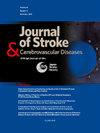Residual inflammatory risk is associated with leukoaraiosis in patients with ischemic stroke
IF 2
4区 医学
Q3 NEUROSCIENCES
Journal of Stroke & Cerebrovascular Diseases
Pub Date : 2025-02-21
DOI:10.1016/j.jstrokecerebrovasdis.2025.108261
引用次数: 0
Abstract
Objective
Emerging evidence has highlighted the clinical significance of residual inflammation risk (RIR) in cardiovascular and cerebrovascular diseases, with studies demonstrating its association with disease recurrence and poor prognosis. This study aimed to investigate the relationship between RIR and leukoaraiosis (LA) severity in patients with ischemic stroke.
Methods
In this observational cohort study, we classified patients into four groups based on low-density lipoprotein cholesterol (LDL-C) and high-sensitivity C-reactive protein (hsCRP) levels: RIR (LDL-C < 2.6 mmol/L and hsCRP ≥ 2 mg/L), residual cholesterol risk (RCR) (LDL-C ≥ 2.6 mmol/L and hsCRP < 2 mg/L), both risk or residual cholesterol and inflammatory risk (RCIR) (LDL-C ≥ 2.6 mmol/L and hsCRP ≥ 2 mg/L) and neither risk (LDL-C < 2.6 mmol/L and hsCRP < 2 mg/L). LA presence and severity were assessed using magnetic resonance imaging (MRI) and graded according to the Fazekas scale. Ordinal logistic regression analyses were performed to evaluate the association between RIR and LA severity.
Results
Among 643 enrolled patients, 413 (64.2 %) exhibited LA. The distribution of patients across RIR, RCR, RCIR, and neither risk groups was 28.9 %, 19.8 %, 20.4 %, and 30.9 %, respectively. Comparative analysis revealed that LA patients exhibited significantly higher age (P < 0.001), elevated BMI (P < 0.001), increased hypertension prevalence (P = 0.004), greater RIR proportion (P < 0.001), and higher smoking rates (P = 0.007) compared to non-LA counterparts. Ordinal logistic regression analysis demonstrated that RIR (OR 1.447, 95 % CI 1.044−1.851, P < 0.001) was independently associated with the severity of LA after adjusting for multiple confounding variables. Subgroup analysis stratified by BMI further revealed that RIR (OR 2.994, 95 % CI 2.259−3.730, P < 0.001) was significantly correlated with LA severity in patients with a BMI ≥ 25.0.
Conclusions
These findings suggest that RIR may serve as an independent risk factor for LA in patients with ischemic stroke, particularly among those with a BMI ≥25.0.
求助全文
约1分钟内获得全文
求助全文
来源期刊

Journal of Stroke & Cerebrovascular Diseases
Medicine-Surgery
CiteScore
5.00
自引率
4.00%
发文量
583
审稿时长
62 days
期刊介绍:
The Journal of Stroke & Cerebrovascular Diseases publishes original papers on basic and clinical science related to the fields of stroke and cerebrovascular diseases. The Journal also features review articles, controversies, methods and technical notes, selected case reports and other original articles of special nature. Its editorial mission is to focus on prevention and repair of cerebrovascular disease. Clinical papers emphasize medical and surgical aspects of stroke, clinical trials and design, epidemiology, stroke care delivery systems and outcomes, imaging sciences and rehabilitation of stroke. The Journal will be of special interest to specialists involved in caring for patients with cerebrovascular disease, including neurologists, neurosurgeons and cardiologists.
 求助内容:
求助内容: 应助结果提醒方式:
应助结果提醒方式:


